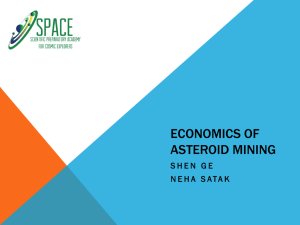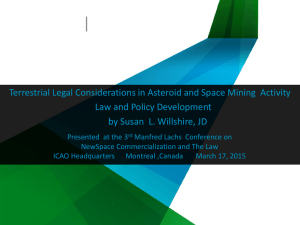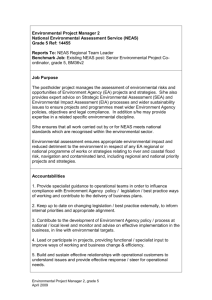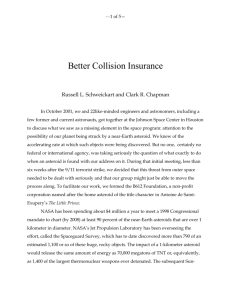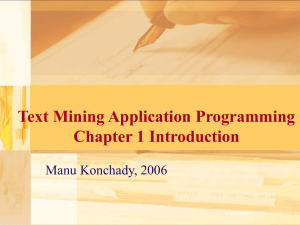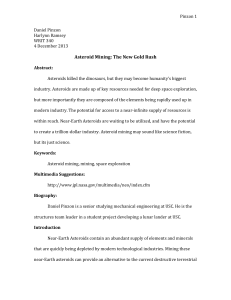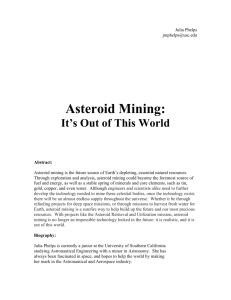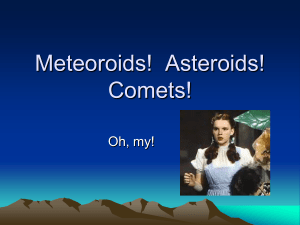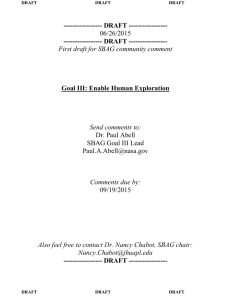Shen Ge : Asteroid Mining Concepts
advertisement
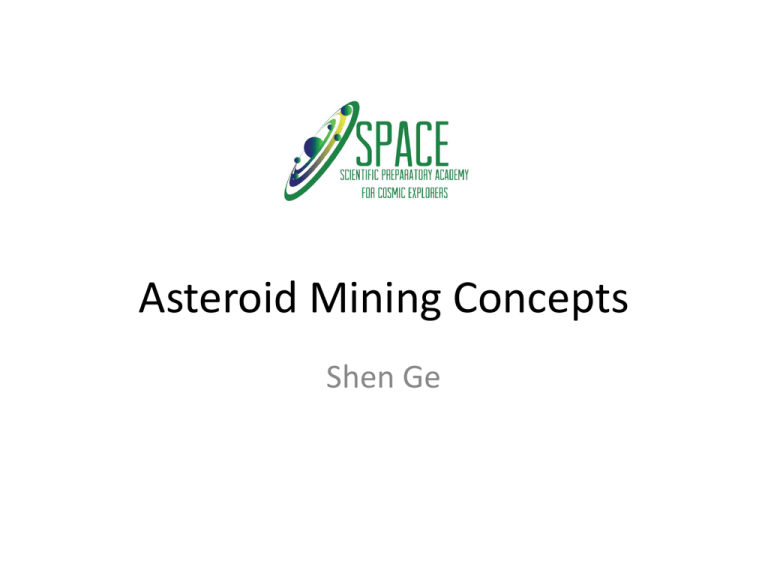
Asteroid Mining Concepts Shen Ge Near-Earth Asteroids • Near-Earth Asteroids (NEAs) of interest due to the relative ease of reaching them. • All NEAs have distances of less than 1.3 AUs. Images from William K Hartmann Known Near-Earth Asteroids Data from JPL Asteroid Resources Chart from Charles Gerlach Growing Interest in Space Mining Important Questions Asteroid Composition Mining Technologies Astrodynamics and Propulsion Economic Analysis What resources do NEAs offer? C-type Carbonaceous (water, volatiles) S-type Stony (silicates, sulfides, metals) M-type Metallic (metals) Potential Products from NEAs Material Product Raw silicate Ballast or shielding in space Water and other volatiles Propellant in space Nickel-Iron (Ni-Fe) metal Space structures Platinum Group Metals (PGMs) Catalyst for fuel cells and auto catalyzers Semiconductor metals Space solar arrays How do we mine them? Type of Material Process Water and other liquids Drillholes. Sulfur Frasch process Metals - If large, need to grind and crush them with feeders, crushers, fluid energy mills, hammer mills, etc. - If small, need to separate the metals by electrostatic or magnetic separation, sieves, carbonyl separation, or cutting. Required Asteroid Mining System Chart from Brad R. Blair and Leslie S. Gertsch How do we get there? • We want to find the asteroids with low deltavs to reduce propellant needed. Distribution of specific linear momentum of a Hohmann transfer from low Earth orbit (LEO) to NEAs according to Benner. 1st WARNING: For Virgil and other non-science or engineering majors who apparently gets a headache from seeing equations, please turn your head away from the next slide. Rocket Equation where Δv = velocity change Ve = exhaust velocity Mo = total mass Mp = propellant mass Two Options: 1. Reduce delta-v required for trajectories to enable low-thrust propulsion methods such as electric, solar thermal, or solar sail propulsion. 2. Use chemical propulsion for high thrust trajectories if needed. Example of a Hohmann Transfer “Apollo-Type” Mission Low Delta-vs for Many NEAs Compare! Interplanetary Superhighway Low delta-v trajectories combined with electric or solar propulsion can open the pathway to many more asteroids previously considered impossible to reach. Or maybe bring the asteroid here… • Use gravity assists to bring candidates into a stable orbit around Earth or • Modify orbits of temporarilycaptured objects (TCOs) to make them stable orbits. Diagrams from Mark Sonter Even NASA is interested… Can we justify the costs? • The economic justification for an asteroid mining operation is only the case if the net present value (NPV) is above zero. • It is NOT just the cost of mining and going there versus the profit obtained from resources. • Sonter has done extensive work in creating a formula for these calculations. 2nd WARNING: For Virgil and other non-science or engineering majors who apparently gets a headache from seeing equations, please turn your head away from the next slide. Sonter’s NPV Equation • • • • • • • • • • • • • • Corbit is the per kilogram Earth-to-orbit launch cost [$/kg] Mmpe is mass of mining and processing equipment [kg] f is the specific mass throughput ratio for the miner [kg mined / kg equipment / day] t is the mining period [days] r is the percentage recovery of the valuable material from the ore ∆v is the velocity increment needed for the return trajectory [km/s] ve is the propulsion system exhaust velocity [km/s] i is the market interest rate a is semi-major axis of transfer orbit [AU] Mps is mass of power supply [kg] Mic is mass of instrumentation and control [kg] Cmanuf is the specific cost of manufacture of the miner etc. [$/kg] B is the annual budget for the project [$/year] n is the number of years from launch to product delivery in LEO [years]. Expectation Value of NPV • NPV should take into account the risk of failure. Exp NPV = p x NPV where p = fractional probability of outcome The Next Steps • Asteroid Composition. Create database of NEAs of interest for resource extraction with their orbits and compositions. • Space Mining. Develop potential mining technologies for modified use in space. • Astrodynamics. Design optimal trajectories and propulsion methods to go there and back. • Space Economics. Identify costs and returns as well as potential investors. Questions?
